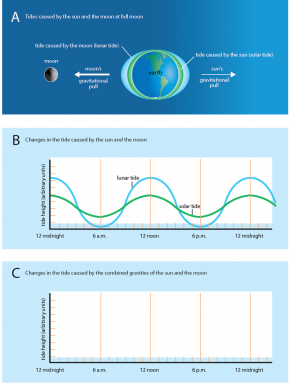Printer Friendly
Title
Further Investigations: Tide Formation—Gravitational Pull
-
Fig. 6.8. Changes in tide levels when the sun, the moon, and the earth are in line. (A) Tides caused by the sun and the moon during full moon (B) Changes in the tide caused by the sun and the moon (C) Changes in the tide caused by the combined gravitational pulls of the sun and the moon.
Using the tide graphs you produced in Activity: Tide Formation—Gravitational Pull, how could you predict what the tides would be on any given day of the month of March? (Recall that the tide graph you drew in Fig. 6.8 C occurred on March 1.) Show your predictions by making a one-month tide graph.
- Tides are formed by the combined gravitational pull of the moon and the sun on Earth’s water and Earth’s daily rotation. Think back on Activity: Kinesthetic Model of the Sun, the Moon, and the Earth and Activity: Tide Formation—Gravitational Pull to answer the following questions.
- How would the moon, the sun, and the earth be positioned to achieve the greatest possible tides?
- What is this specific astronomical arrangement called?
- When is the next time this event will occur?
- Research how the earth’s rotation affects the tides. Animations that include the effects of the moon, sun, and Earth’s rotation may be helpful (e.g., Tidal Bulge Simulation)
- Prepare a presentation about the Hawaiian moon phases. Here are some websites to start your research:
Exploring Our Fluid Earth, a product of the Curriculum Research & Development Group (CRDG), College of Education. © University of HawaiФi, 2011. This document may be freely reproduced and distributed for non-profit educational purposes.








